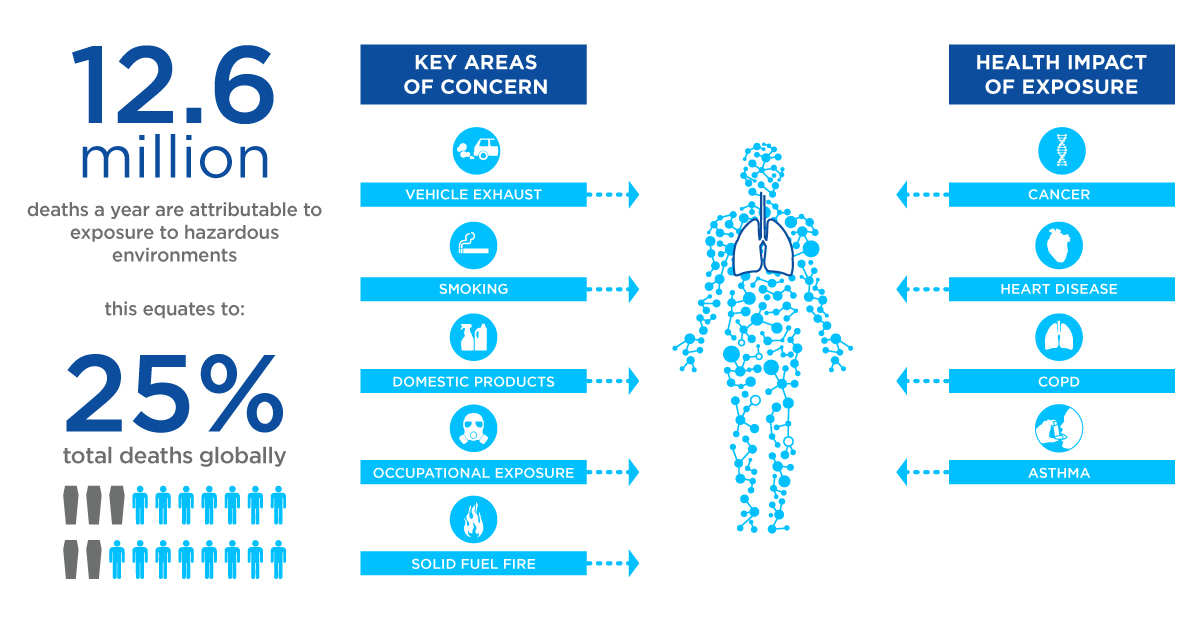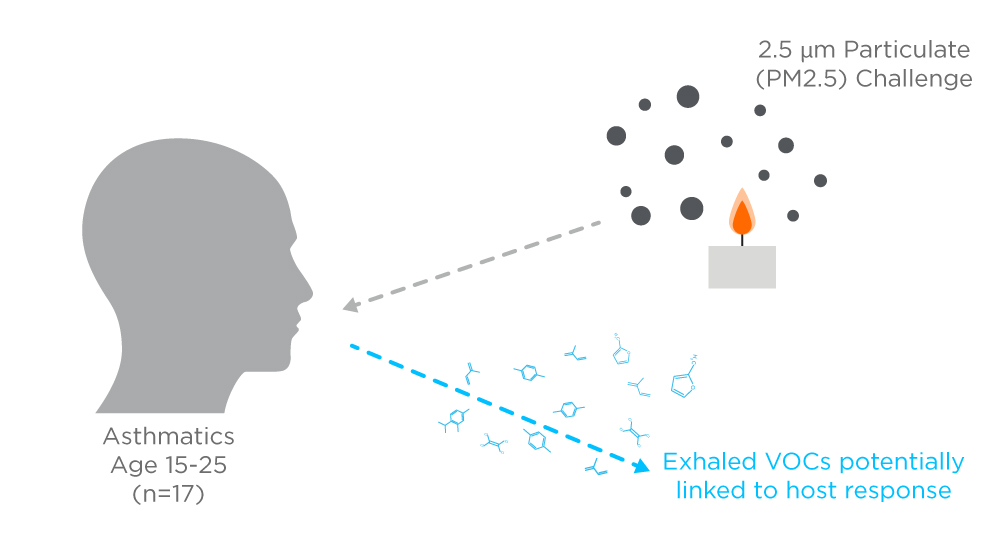Breath Analysis for Non-Invasive Exposure Research
Published on: 20 Sep 2022
The World Health Organization reports that 1 in 4 global deaths are due to an unhealthy living or working environment and environmental risk factors, such as air, water and soil pollution, chemical exposures, climate change, and ultraviolet radiation, which together contribute to more than 100 types of diseases and injuries.

The diagnosis of health concerns related to exposure can be difficult as symptoms can take years to materialize and are often mild during the early stages.
Discovering biomarkers that act as early indicators of hazardous exposures or pre-clinical signs of elevated disease risk could make it possible to move beyond diagnosis and treatment of exposure-related diseases into actual prediction and prevention of adverse outcomes.
How is breath relevant to environmental exposure?
Exhaled breath is a non-invasive alternative to blood sampling. Breath contains volatile organic compounds (VOCs) originating as products of the body’s metabolism (endogenous VOCs) or from external sources such as diet, occupational exposure, and environmental exposure (exogenous VOCs).
VOCs in breath include some commonly related to hazardous exposures such as benzene, toluene, ethylbenzene, and xylenes (BTEX). These and other exogenous VOCs could originate directly from, and be used to assess, external exposures. In addition, endogenous VOCs, released from airway tissues or making their way to the breath via blood gas exchange in the lung, could be biomarkers of the detrimental downstream effects of exposure. They might relate to internal processes such as oxidative stress, lipid peroxidation, and inflammation.
We are deploying our Breath Biopsy® technology as part of the EU-funded Exposome Project for Health and Occupational Research (EPHOR), a consortium to advance occupational health science to reduce disease burden from workplace exposure. EPHOR aims to develop the working-life exposome, defined as all occupational and related non-occupational exposure factors and the body’s biological response, to lay the groundwork for evidence-based and cost-effective preventive actions to improve working life health and reduce the burden of exposure-related diseases.
Recent studies in breath analysis for exposure science
Quite a lot of progress has been made in the last five years. Recent studies have demonstrated direct evidence of the human health impacts of pollution and identified potential VOC biomarkers for exposure [1]. One way to understand the effects of exposures on cells and to examine the endogenous VOCs that might be produced in response to exposures and that could be detected on breath is through in vitro studies on disease cell lines. Janssens et al. recently published work on the utilization of VOCs in breath as potential biomarkers for malignant pleural mesothelioma (MPM) diagnosis [2]. MPM is a type of rare cancer that develops in the pleura, the thin membrane that lines the lungs and chest cavity, and early-stage diagnosis remains a major challenge. MPM is usually caused by exposure to asbestos.
The authors investigated VOC production at the cellular level using an in vitro model to characterize the headspace VOC profiles of six MPM and two lung cancer cell lines using thermal desorption-gas chromatography-mass spectrometry.
VOC profiles were identified capable of distinguishing MPM (subtypes) and lung cancer cells with high accuracy. Twenty-four VOCs were found to be important in the discrimination, of which propyl benzene and trichloromethane could be tentatively identified by matching to the online NIST mass spectral library.
The paper concludes with a call for further work to establish a clinically useful breath model for MPM, ‘in vitro VOC analysis can provide valuable additional information.’ You can watch our webinar, ‘Identifying Translational Biomarkers for Diagnostics and Drug Development using Breath Biopsy In Vitro Headspace Analysis’, to learn how we can support your in vitro exposure research.
Watch our in vitro analysis webinar
Silicosis is a type of pulmonary fibrosis, caused by inhaling large amounts of crystalline silica dust, which affects workers in jobs such as construction and mining. In early stages, symptoms are mild making a diagnosis difficult but once the lung scarring has become more severe, there are a variety of symptoms that may appear. Xuan et al. discussed the use of breath tests for silicosis screening and early detection in miners [3].
Exhaled breath of 398 non-silicosis miners and 221 silicosis miners was analyzed, all subjects were included in the screening model, and an early detection model was run for silicosis cases in stage I. The study used an eNose device based on an array of organic nanofiber sensors, which means their results did not identify specific VOCs. The resulting screening and early detection models had accuracies of between 0.817 and 0.987, which they reported as having potential for large-scale silicosis screening, especially as personal smoking habits had little impact on the results. However, more work will be needed to demonstrate whether the same patterns of sensor responses can be applied to broader population of miners and other industrial contexts.
We recently conducted a study, alongside our collaborators Prof. Torben Sigsgaard and Dr. Karin Rosenkilde Laursen at the Department of Public Health, Aarhus University, Denmark, looking at exposure-induced acute lung inflammation using breath analysis. 17 non-smoking asthmatics participated in two sessions with exposure to emissions from two different candles. Breath samples were compared to blanks to ensure only VOCs arising from breath, and not ambient air or collection equipment, were analyzed. 10 VOCs showed statistically significant differences between pre-exposure and immediate post-exposure samples, indicating they may represent an acute inflammatory response to exposure in the lung tissue. These changes generally returned to normal 24 hours later showing rapid recovery from short-term exposure. It is unlikely the changes in VOCs would be as short-lived for those suffering from ongoing or repeated exposure.

Breath Biopsy for Exposure Research
We are the world-leader in Breath Biopsy® for early detection and precision medicine. Breath Biopsy has the potential to be a vital tool in the development of exposure research, ultimately helping to save lives from exposure-related disease and prevent the additional healthcare spending that’s required when these diseases are diagnosed late.
Breath Biopsy products such as the ReCIVA® Breath Sampler are designed for reproducible and reliable collection of VOCs from human breath. Supported by expertise in study design, management, analysis and interpretation, our Breath Biopsy OMNI® service is the most advanced solution for global breath VOC analysis. Get in touch to discuss studying VOC biomarkers of environmental exposure using Breath Biopsy.
Breath Biopsy OMNI current projects in exposomics Let’s chat
References
- Zhang L, Li X, et al. Haze Air Pollution Health Impacts of Breath-Borne VOCs. Environmental Science & Technology. 2022 56 (12), 8541-8551 DOI: 10.1021/acs.est.2c01778
- Janssens E, Mol Z, Vandermeersch L, et al. Headspace Volatile Organic Compound Profiling of Pleural Mesothelioma and Lung Cancer Cell Lines as Translational Bridge for Breath Research [Original Research]. Frontiers in Oncology. 2022 2022-May-06;12. DOI: 10.3389/fonc.2022.851785
- Xuan W, Zheng L, Bunes BR, et al. Engineering solutions to breath tests based on an e-nose system for silicosis screening and early detection in miners. J Breath Res. 2022 Apr 7;16(3). DOI: 10.1088/1752-7163/ac5f13